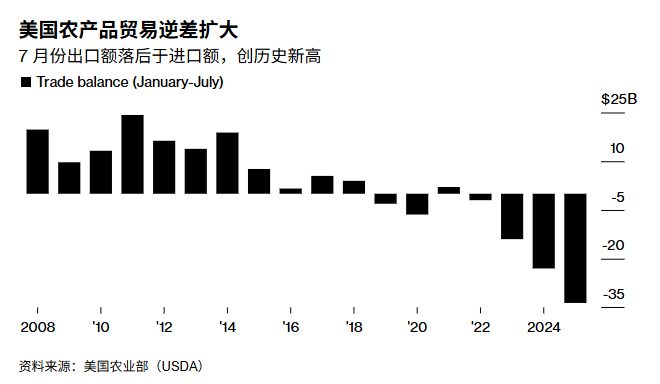The U.S. agricultural trade deficit widened further in July, highlighting the challenges President Donald Trump faces in reversing this trend.
Data released by the U.S. Department of Agriculture on Monday showed that agricultural exports lagged behind imports by $4.97 billion in July, with the gap widening by 9% compared to the same period last year, setting a record for the month. This has pushed the trade deficit in agricultural products for the first seven months of this year to an unprecedented $33.6 billion.

The main reason for the expansion of the trade deficit in agricultural products this year is the sharp increase in imports. Meanwhile, Trump has imposed tariffs on other countries in an attempt to reduce the overall trade deficit. This further solidifies the transformation that has been taking place since the president’s first term: the agricultural sector, which has long maintained a huge trade surplus, is gradually becoming a net importer.
This change in fortune stems from the constraints on the expansion of agricultural and livestock production capacity, intensified overseas competition, and the continuous growth in Americans’ demand for imported goods. Trump’s trade war has also played a role, forcing China, the world’s largest importer of agricultural products, to rely more on Brazil’s supply. The United States has also processed more of its agricultural products domestically for the production of biofuels, thereby reducing the surplus output available for export.
In the first seven months of 2025, the United States imported over 132 billion US dollars worth of agricultural products, an increase of nearly 8% year-on-year. Meanwhile, according to data from the US Department of Agriculture, agricultural product exports declined by 1.3% to 98.8 billion US dollars.
The United States officially implemented a new round of comprehensive tariffs in August, further increasing the rates on top of the benchmark rates imposed in April.
Under the leadership of successive administrations, the United States has developed “granary diplomacy”, using its abundant agricultural resources as both a “carrot” and a “stick”. Exporting surplus crops to overseas in the form of aid or trade has become a low-risk way to maintain relations. Prohibiting the sale of food to hostile forces has also been proven to be an effective diplomatic policy tool.
Today, the source of strength for American agriculture is rapidly shrinking. For most of the past seven decades, the United States has been the world’s largest exporter of corn, soybeans and wheat. However, it is now facing a persistent agricultural trade deficit. According to the U.S. Department of Agriculture, the trade deficit for the fiscal year ending September 30 is estimated at 19 billion U.S. dollars, and it is expected to soar to nearly 28 billion U.S. dollars by the fiscal year 2024.
At present, the United States accounts for less than one-third of global soybean exports, equivalent to half of Brazil’s exports. It ranks fourth in wheat exports, lagging far behind Russia, which is in the first place. “Look at where Russia’s grain exports go, and then look at the countries that did not sign the UN resolution against Russia. The lists are basically the same,” said Nielsen, referring to a meeting held on March 2 last year when five countries voted against condemning Russia’s invasion of Ukraine, and 35 countries, including China, India and South Africa, abstained.
Similarly, Trump’s trade war with China has also accelerated China’s efforts to reduce its reliance on US grains and other food supplies. In 2022, US products accounted for 18% of China’s total agricultural imports, down from 27% in 2009.